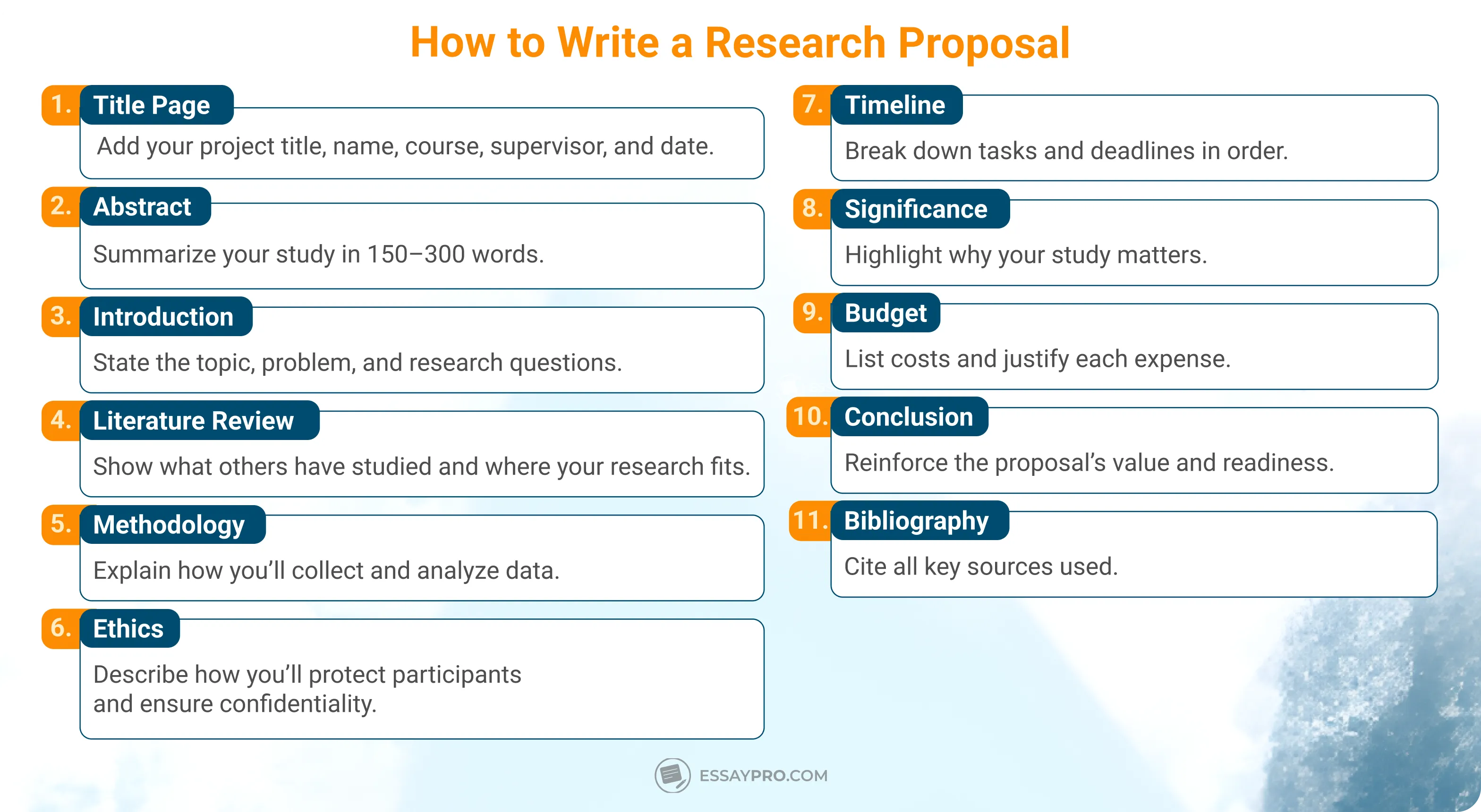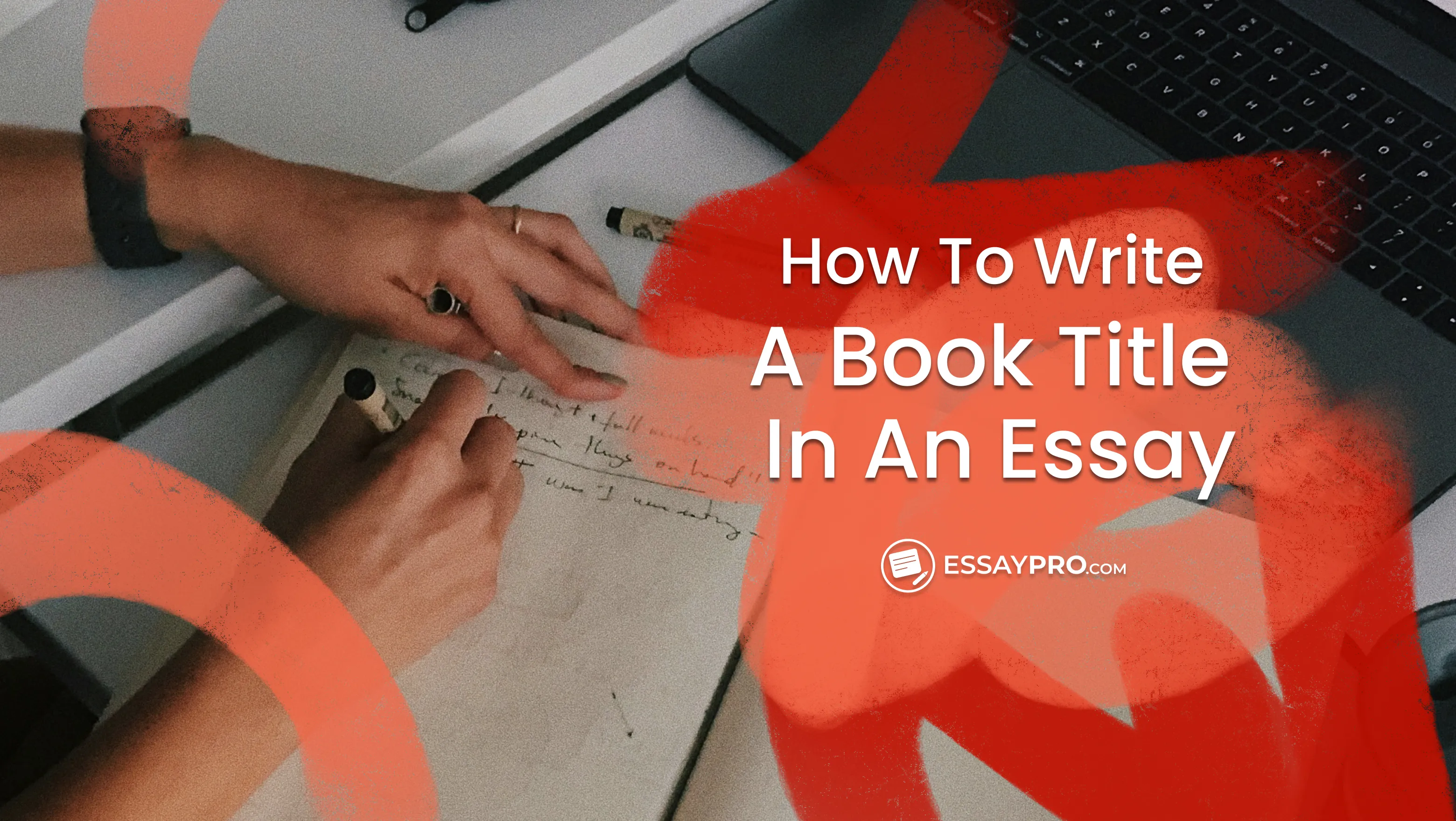A research proposal is a formal plan outlining your research and how you are going to proceed with carrying it out. It identifies knowledge gaps and the means by which you will gather data and analyze it. The following steps show how to write a research proposal:
- Pick a clear and focused topic. What specific question are you trying to answer?
- Show its importance. Why is your research relevant to your field?
- Research the gap. What do we already know? What are the knowledge gaps you'll address?
- Plan your methods. How will you collect and analyze your data (surveys, interviews, experiments)?
- Be realistic. Can you complete the research within your timeframe?
- Cite your sources! Show you've reviewed existing research.
- Keep it concise. Aim for a clear and focused document, typically 5-10 pages.
Professional guidance can make all the difference when you're dealing with something you don't entirely know how to write. EssayPro can help with expert research proposal writing service, so you can be confident while submitting your work.
What Is a Research Proposal
The proposal combines a call to action, a request for financial support, and a mission statement. It's a creative work that unites the brilliance of creation with the powerful ability to persuade, opening up a whole new range of alternatives.
Why You Need a Research Proposal
A research proposal explains what you want to study and how you intend to do it. It also explains the significance that the research shows. This document allows the reviewers to see a clear plan that proves the project is relevant and doable. If you're one of those students who wants to know what does a research proposal look like, the answer is simple: it's a detailed yet short text that tells of purpose, background, and methods.
Research Proposal Length
The length of a research proposal can vary depending on several factors, but here's a quick guide:
- Typical Range: 1,500 - 3,000 words (excluding references and appendices).
- Ballpark Pages: 5-10 pages (assuming standard formatting).
- Focus on Quality, Not Quantity: Aim for a concise and well-structured document that effectively conveys your research plan.
Remember:
- Check with your specific program or funding agency for any word or page limit requirements.
How to Write a Research Proposal Step-by-Step
Always take the process one step at a time when writing a proposal. Every section in the text has its own job, and they need to be handled separately to create a connected story. If you're asking yourself how to start a research proposal, here's the start: focus first on the layout. Move through the document step by step.

Title of the Paper
The title is the first step in preparing a research proposal. It's the thing that creates the first impression, so it must include:
- The title of your research project
- Your name and academic affiliation
- The course or program name
- The supervisor’s name
- The date of submission
Abstract
An abstract provides a 150-300 word summary of a research paper and its primary objectives, methods, results, and conclusions. As it is frequently the first thing readers see and can influence whether they continue reading the complete article, the abstract is an important part of a research study. An effective abstract should summarize the paper's ideas, be simple to read, and emphasize the importance and possible influence of the work. It should give readers a thorough understanding of the paper's scope and purpose while piquing their interest in learning more.
Introduction
The introduction opens the proposal. The first part of your research proposal explains what you're planning to research and why it matters. In this section, you should also cover what questions you aim to answer with your study. Show the reviewers you've done the background check to justify the significance of your project. When working on the preparation of a good quality research proposal, make sure the introduction includes:
- A clear overview of the topic
- A statement of the problem you aim to solve
- Justification for why the study matters
- Specific objectives and research questions
- An outline of the research approach
Literature Review
The literature review places your work in context. This part examines what has already been written on the topic by other researchers. This part includes an analysis of existing relevant studies so you can prove your research fits within the field. Credible sources show that your project is based on solid academic ground. Besides, you also show that it can contribute something new. This step is crucial in writing research proposal documents that stand out.
Methodology
The methodology explains how you intend to turn your research idea into something concrete. It is where you walk the reader through your chosen approach and why it fits the project. While building a research proposal, use this section to describe the techniques you'll use to collect information: talk about the tools and resources, along with how you plan to process the data. If certain frameworks or earlier studies support your choice of methods, refer to them here. This section should leave no doubt that you have a clear, workable plan.
Ethical Responsibilities
Ethics are at the heart of any good study. This part explains how you will protect the people involved and maintain professional standards throughout the process. Write about how you will secure informed consent and the steps you will take to keep data private. Mention how you will guarantee anonymity and describe the measures you will use to reduce any possible harm. If the research involves vulnerable groups, make it clear how you will handle those situations with extra care.
Timeframe
A project without a timeline is difficult to follow, so this section matters both for you and for those reviewing your proposal. It lays out how you plan to move through the work, stage by stage. Show the order of tasks and the deadlines you set for each one. Keeping this information in a table makes it easy to read and understand.
Significance
Afterward, you should describe the significance of your work. Every research proposal sample will briefly explain how your research is unique and contributes to the topic of study. You might wish to provide reasoning for the necessity of your study at this given moment.
For example: 'The study's findings connect Psycho with other contemporary movies that share the same shock-factor traits. The startling aspect is more difficult to create today, as seen by the rise of low-budget, badly made horror movies that rely on shock rather than suspense to keep viewers' interest.'
Budget
When your research needs funding, a budget becomes a key part of composing research proposal. It shows you have thought through the financial side of things and that every expense has a reason behind it. Write down everything you'll have to spend money on and explain why you need them. A clear table keeps everything transparent, so it's probably the best method to approach this.
Conclusion
The conclusion brings the proposal to a close without adding anything new. Use this space to remind the reader why the study is worth doing. Point out the value it can bring to the field and leave them with a sense that your plan is strong and ready to move forward.
Bibliography
Finally, you should compile a list of the articles and books most helpful to your research. You may need to do so according to the guidelines set forth by your instructor for research papers (APA, MLA, Chicago, etc.). You could also develop an annotated bibliography in which you explain how each resource aided your inquiry.
Research Proposal Outline
Here's an overview of what your proposal outline should include. Make sure to keep notes to organize your writing:
I. Introduction
- Background information and context
- Research problem statement
- Research question(s) or hypothesis
II. Literature Review
- Review of relevant literature
- Identification of gaps in existing research
- Explanation of how the proposed research will address those gaps
III. Methodology
- Research design
- Participants or population
- Sampling method
- Data collection methods
- Data analysis methods
IV. Expected Results
- Discussion of expected outcomes
- Significance of expected outcomes
V. Timeline
- Project timeline with major milestones
VI. Budget
- Itemized budget with justification for expenses
VII. Conclusion
- Recap of the research problem and proposed solution
- Potential contributions to the field of study
VIII. References
- List of references cited in the proposal
For a well-thought-out research paper outline, please consult our dedicated article.


Formatting Your Research Proposal in APA
The APA style is one of the most commonly used formats for research proposals because it organizes sections very clearly. This style follows the rules set by the American Psychological Association. Here is the general APA outline format:
- 12-point font Times New Roman.
- Double-spaced.
- 1-inch margins.
- An APA running head (limited to 50 characters).
- A title page with the paper's title (no more than 12 words in length), your name, and the name of your institution.
- An abstract (150-200 words).
- In-text citations.
- References page.
Read also: How to cite a research paper.
To Sum Up
To wrap up, we hope our article assisted you in writing a research proposal. In addition to providing a thorough analysis of all the crucial elements of a research project, we provided guidance on how to write a research paper proposal that stands out.
And if you're already prepared to start producing a scholarly research paper, you can always rely on us! Contact us with your 'write my research paper' request to place an order for a quality paper that will easily impress your professor!
Want to Achieve Top Grades Effortlessly?
Whether you're among scholars seeking grant funding or simply need help writing just a course assignment, EssayPro here to assist!
FAQ
What Are the 5 Steps of Writing a Research Proposal?
Here are the five steps to writing a research proposal:
- Begin with a topic that centers on a clear question.
- Read existing studies to understand where your research fits.
- Sketch an outline that maps out how the proposal will develop.
- Write each section in order
- Review and proofread the draft
How Long Should a Research Proposal Be?
A typical proposal runs anywhere between five and ten pages. Smaller assignments might be shorter, while larger projects can stretch longer.
What Is the Format of a Research Proposal?
The format usually follows a clear structure:
- Start with a title page to open the proposal.
- Move into the introduction, followed by a review of existing literature.
- Add a section that explains how the research will be carried out.
- End with a conclusion and a list of references.
- Include extra parts such as a timeline or budget when required.

Daniel Parker
is a seasoned educational writer focusing on scholarship guidance, research papers, and various forms of academic essays including reflective and narrative essays. His expertise also extends to detailed case studies. A scholar with a background in English Literature and Education, Daniel’s work on EssayPro blog aims to support students in achieving academic excellence and securing scholarships. His hobbies include reading classic literature and participating in academic forums.
- How to write a research proposal. (2025). The University of Sydney. https://www.sydney.edu.au/study/help/advice/how-to-write-a-research-proposal.html
- Duggappa, D. R., Sudheesh, K., & Nethra, S. (2016). How to write a research proposal? Indian Journal of Anaesthesia, 60(9), 631. https://doi.org/10.4103/0019-5049.190617






